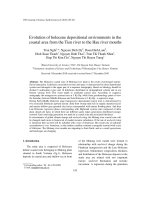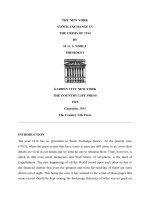vaughan-whitehead - work inequalities in the crisis; evidence from europe (2011)
Bạn đang xem bản rút gọn của tài liệu. Xem và tải ngay bản đầy đủ của tài liệu tại đây (13.25 MB, 613 trang )
Work Inequalities in the Crisis
M2778 - VAUGHAN TEXT.indd iM2778 - VAUGHAN TEXT.indd i 27/10/2011 12:1827/10/2011 12:18
M2778 - VAUGHAN TEXT.indd iiM2778 - VAUGHAN TEXT.indd ii 27/10/2011 12:1827/10/2011 12:18
Work Inequalities in
the Crisis
Evidence from Europe
Edited by
Daniel Vaughan-Whitehead
Senior Adviser, Responsible for Wage Policies,
International Labour Office, Geneva, Switzerland
Professor, Sciences Po, Paris, France
Edward Elgar
Cheltenham, UK • Northampton, MA, USA
International Labour Office
Geneva, Switzerland
M2778 - VAUGHAN TEXT.indd iiiM2778 - VAUGHAN TEXT.indd iii 27/10/2011 12:1827/10/2011 12:18
© International Labour Organization 2011
All rights reserved. No part of this publication may be reproduced, stored in a retrieval
system or transmitted in any form or by any means, electronic, mechanical or
photocopying, recording, or otherwise without the prior permission of the publisher.
Publications of the International Labour O ce enjoy copyright under Protocol 2 of the
Universal Copyright Convention. Nevertheless, short excerpts from them may be
reproduced without authorization, on condition that the source is indicated. For rights of
reproduction or translation, application should be made to ILO Publications (Rights and
Permissions), International Labour O ce, CH-1211 Geneva 22, Switzerland, or by email:
The International Labour O ce welcomes such applications.
The designations employed in ILO publications, which are in conformity with United
Nations practice, and the presentation of material therein do not imply the expression of
any opinion whatsoever on the part of the International Labour O ce concerning the legal
status of any country, area or territory or of its authorities, or concerning the delimitation
of its frontiers.
The responsibility for opinions expressed in studies and other contributions rests solely with
their authors, and publication does not constitute an endorsement by the International
Labour O ce of the opinions expressed in them.
Reference to names of rms and commercial products and processes does not imply their
endorsement by the International Labour O ce, and any failure to mention a particular
rm, commercial product or process is not a sign of disapproval.
Published by
Edward Elgar Publishing Limited Edward Elgar Publishing, Inc.
The Lypiatts William Pratt House
15 Lansdown Road 9 Dewey Court
Cheltenham Northampton, MA 01060
Glos GL50 2JA USA
UK
In association with
International Labour O ce
4 route des Morillons
1211 Geneva 22
Switzerland
ISBN 978 92 2 124885 9 (paperback)
A catalogue record for this book
is available from the British Library
Library of Congress Control Number: 2011927325
ISBN 978 0 85793 750 6 (cased)
Cover design by Boroka Gergely; layout by James Patterson
Typeset by Servis Filmsetting Ltd, Stockport, Cheshire
Printed and bound by MPG Books Group, UK
M2778 - VAUGHAN TEXT.indd ivM2778 - VAUGHAN TEXT.indd iv 27/10/2011 12:1827/10/2011 12:18
v
Contents
List of contributors vii
Foreword by Maria Helena André ix
Foreword by Nicolas Schmit xii
Foreword by Guy Ryder xv
1. Introduction: Has the crisis exacerbated work inequalities? 1
Daniel Vaughan- Whitehead
2. Mixed adjustment forms and inequality e ects in Estonia,
Latvia and Lithuania 38
Jaan Masso and Kerly Krillo
3. Inequality at work emerging in the current crisis in Bulgaria 103
Vasil Tzanov
4. Croatia: Prolonged crisis with an uncertain ending 143
Vojmir Franičević
5. France: Protecting the insiders in the crisis and forgetting the
outsiders? 198
Jérôme Gautié
6. The German labour market after the nancial crisis: Miracle
or just a good policy mix? 243
Gerhard Bosch
7. Hungary: Crisis coupled with a scal squeeze – e ects on
inequality 278
János Köllő
8. Italy: Limited policy responses and industrial relations in ux,
leading to aggravated inequalities 314
Niall O’Higgins
9. The Netherlands: Is the impact of the nancial crisis on
inequalities di erent from in the past? 350
Wiemer Salverda
10. From the highest employment growth to the deepest fall:
Economic crisis and labour inequalities in Spain 393
Rafael Muñoz de Bustillo Llorente and
José- Ignacio Antón Pérez
M2778 - VAUGHAN TEXT.indd vM2778 - VAUGHAN TEXT.indd v 27/10/2011 12:1827/10/2011 12:18
vi Work inequalities in the crisis
11. Negotiated exibility in Sweden: A more egalitarian response
to the crisis? 445
Dominique Anxo
12. Crisis in Turkey: Aggravating a segmented labour market
and creating new inequalities 477
Seyhan Erdoğdu
13. Social impact of the crisis in the United Kingdom: Focus on
gender and age inequalities 525
Damian Grimshaw and Anthony Ra erty
Index 571
M2778 - VAUGHAN TEXT.indd viM2778 - VAUGHAN TEXT.indd vi 27/10/2011 12:1827/10/2011 12:18
vii
Contributors
Dominique Anxo Professor of Economics and Director of the Centre
for Labour Market Policy Research, School of Management and
Economics, Department of Economics and Statistics, Linnaeus
University, Sweden.
Gerhard Bosch Professor of Sociology, University of Duisburg- Essen,
Executive Director of the Institut für Arbeit und Quali kation (Work and
Skills IAQ), Germany.
Seyhan Erdoğdu Associate Professor, Department of Labour Economics
and Industrial Relations, Faculty of Political Science, Ankara University,
Turkey.
Vojmir Franičević Professor of Economics and Political Economy,
Faculty of Economics, University of Zagreb, Croatia.
Jérôme Gautié Professor of Economics, University of Paris I Panthéon-
Sorbonne, France.
Damian Grimshaw Professor of Employment Studies and Director
of EWERC (European Work and Employment Research Centre),
Manchester Business School, University of Manchester, United
Kingdom.
János Köllő Senior Research Fellow, Institute of Economics, Hungarian
Academy of Sciences, Budapest, Hungary.
Kerly Krillo Senior Research Fellow, Faculty of Economics and Business
Administration, University of Tartu, Estonia.
Jaan Masso Senior Research Fellow, Faculty of Economics and Business
Administration, University of Tartu, Estonia.
Rafael Muñoz de Bustillo Llorente Professor of Economics, Faculty of
Economics, University of Salamanca, Spain.
Niall O’Higgins Professor of Economics, University of Salerno, Italy.
José- Ignacio Antón Pérez Senior Research Fellow, Faculty of Economics,
University of Salamanca, Spain.
M2778 - VAUGHAN TEXT.indd viiM2778 - VAUGHAN TEXT.indd vii 27/10/2011 12:1827/10/2011 12:18
viii Work inequalities in the crisis
Anthony Ra erty Senior Research Fellow, Manchester Business School,
University of Manchester, United Kingdom.
Wiemer Salverda Director of the Amsterdam Institute for Advanced
Labour Studies (AIAS) of the University of Amsterdam and coordinator
of the European Low- Wage Employment Research Network (LoWER),
the Netherlands.
Vasil Tzanov Senior Research Fellow, Institute of Economics, Bulgarian
Academy of Sciences, So a, Bulgaria.
Daniel Vaughan- Whitehead Senior Adviser, Responsible for Wage
Policies, International Labour O ce, Geneva, Switzerland. Professor,
Sciences Po, Paris, France.
M2778 - VAUGHAN TEXT.indd viiiM2778 - VAUGHAN TEXT.indd viii 27/10/2011 12:1827/10/2011 12:18
ix
Foreword
Maria Helena André
This book is important in many respects. It is essential to look at the rise
in inequalities during the crisis and how we should address this issue in the
post- crisis period. This leads me to a series of questions. Where should we
go after the crisis and what model should we pursue? The same model or
a new one? Can we even think of returning to the same kind of regulation
– in fact, the lack of regulation, especially of nancial markets – that put
us where we are now?
Undoubtedly, this crisis will be felt for a long time. Furthermore, both
the job losses and the reduction in activity in many countries mean that we
will not be returning to cruising speed any time soon.
In Portugal, the crisis was exacerbated by the fact that we were under-
taking structural reforms in an e ort to converge with the most developed
EU countries. The crisis has clearly stopped this convergence process.
Two moments in the crisis stand out. First, the focus on bailouts and
second, the current situation in which we will have to resume a policy of
budget de cit reduction, cutting sovereign debt in order to retain our grip
on what comes afterwards. The crisis has certainly led, in Portugal, to an
increase in unemployment and, as shown in this volume, di erent groups
have been a ected in di erent ways. Young people and women have been
particularly hard hit, with substantial rises in their unemployment rates
between the rst and third quarters of 2010.
Although Portugal has been able to sustain economic activity and
growth, especially with regard to exports, there is a large group of unem-
ployed people who need to be taken care of. The group is heterogeneous,
including the highly educated and the low skilled, young workers start-
ing their careers and employees over 35. A whole range of policy goals
is needed to meet the challenge. The priority must be job creation. This
requires economic growth. The government’s rst concern is therefore to
take the necessary steps to achieve this.
At the same time, higher levels of education and training are needed to
prepare the workforce not just for the jobs of today but also for the jobs
of tomorrow: greening the economy, meeting the demographic challenge,
M2778 - VAUGHAN TEXT.indd ixM2778 - VAUGHAN TEXT.indd ix 27/10/2011 12:1827/10/2011 12:18
x Work inequalities in the crisis
indeed everything we have been talking about for years, but which has
been pushed aside due to the crisis. It is not merely the quantity of jobs
that is important, but their quality. This volume proposes a number of
concrete ways forward.
Minimum wages are one way of reducing inequalities. In Portugal,
despite the crisis, we have been able to raise the minimum wage signi -
cantly. This was possible through an agreement signed by the government
and the social partners. The minimum wage has proved to be a powerful
instrument for tackling one of the main pre- crisis problems, the working
poor and a general increase in inequalities in the workplace.
We also need speci c policies for target groups. In Portugal, we have
put in place a major austerity package, but we have also initiated as many
as 50 measures to boost competitiveness and employment, addressing the
functioning of the economy, exports, support for companies, the informal
economy and urban renewal. This agenda is being discussed, measure by
measure, with the social partners, our aim being to achieve consensus, or
at least the broadest possible tripartite acceptance of how this agenda can
be promoted.
We have started a debate on active labour market policy, which will be
fundamental in reducing inequalities. In agreement with the social part-
ners we are developing traineeships, opportunities for young people and,
for the rst time in Portugal, full social protection for trainees. We have
also agreed to create 50,000 new traineeships for young people, with full
protection rights for the rst time in our country. We have also looked
at how best we can support companies to hire those trainees but also to
hire the long- term unemployed. We have produced a programme which is
not as generous as it would have been in the past, but which is still fairly
conducive to the hiring of the long- term unemployed and young people,
reducing social contributions and o ering employers a lump sum, among
other things to transform short- term contracts into open- ended contracts.
We think that this is also a very practical way of reducing inequalities and
of helping people get back into the labour market.
Thirdly, we have launched a new micro- nancing programme for long-
term unemployed young people but also for small and micro- enterprises,
especially in the export sector. This programme is a novelty because it not
only supports people in starting up in business but also provides follow- up
support to try to ensure that the mortality rate of bright ideas is not as
high as in the past. Finally we will also launch a programme to reskill
unemployed university graduates.
To conclude, we should do everything possible to help get people back
into the labour market and to support companies in increasing their activ-
ity. It might be with regulation – such as the minimum wage – or with
M2778 - VAUGHAN TEXT.indd xM2778 - VAUGHAN TEXT.indd x 27/10/2011 12:1827/10/2011 12:18
Foreword xi
targeted measures, but best of all would be a mixture of the two, and with
the close involvement of the social partners. Without their help, we will
not be able to identify the challenges or the best ways of moving forward.
Understanding where we have come from and where we are heading is
probably the most important challenge today.
Maria Helena André
Minister of Labour and Social Solidarity
Portugal
M2778 - VAUGHAN TEXT.indd xiM2778 - VAUGHAN TEXT.indd xi 27/10/2011 12:1827/10/2011 12:18
xii
Foreword
Nicolas Schmit
Inequality was not created by the crisis, although it was perhaps one of
its triggers. Joseph Stiglitz and Patrick Artus in particular stress how,
especially in the United States – where the crisis began – elements such as
work inequality, wage stagnation and the working poor have allowed the
infernal mechanism of sub- prime mortgages to develop due to the unequal
and unregulated redistribution of growth between wages and capital that
has been taking place for more than 20 years.
This phenomenon of increasing inequality is also a ecting Europe, even
Luxembourg, although here we have tried to counter such trends through
a national minimum wage, tax incentives and social transfers. It is also
important to identify those who have su ered most from globalization. It
is the least quali ed, who were traditionally employed in industry where
they enjoyed fair wages and also a high degree of unionization and social
protection, whose jobs started to disappear with globalization and increas-
ing relocation. Even where they managed to keep their jobs, downward
pressure on wages increased dramatically.
Globalization has thus led to a new distribution: between industrialized
countries and emerging countries, on the one hand, and – within our own
societies – between the highly skilled and those with low or no skills, on
the other. The latter were already the most vulnerable, receiving the lowest
wages.
The risk of poverty has become a reality everywhere, even in a
rich society such as Luxembourg which is also under strict budgetary
discipline – although its de cit remains below the 3 per cent threshold.
The risk of poverty in Luxembourg in 2009 was 14.9 per cent, particu-
larly a ecting young workers and people on short- term contracts. The
key element here is precariousness, although this remains undeveloped
in Luxembourg. Nevertheless, we observe the same trend, with short-
term contracts increasing in both absolute and proportionate terms. We
are careful – notably through social dialogue – not to let this process
develop further, but there are increasing external pressures. Although
Luxembourg’s economy is based primarily on services – banking and
M2778 - VAUGHAN TEXT.indd xiiM2778 - VAUGHAN TEXT.indd xii 27/10/2011 12:1827/10/2011 12:18
Foreword xiii
nance – these generally highly quali ed jobs have also been under
attack due to relocation. In particular those involving more mechanical
tasks, such as accounting and computer processing, are coming under
threat.
To these problems there is no single solution. First, Europe must return
to the path of growth because this is the only way to boost employment.
Germany’s good employment performance has been led by export growth,
but this should not be concentrated in one or a few countries but rather
extended throughout Europe. This also involves proper management of
budget consolidation which should not become destructive to growth and
employment as this would increase inequality between European countries
and, consequently, also inequalities within countries. Rights at work –
such as social dialogue, decent working conditions and social protection,
all part of the European Social Model – are also important. We must
ensure that such minimum standards are not dismantled but rather pro-
moted within our competitiveness model, as Jacques Delors emphasized.
Coordination is important, however, because we will not be able to do it
alone. If we progressively accept the dismantling of basic labour rights
and let atypical forms of work dominate, one country after another will
succumb.
Among these basic rights, wages are also crucial. In Luxembourg,
the minimum wage is the highest in Europe, in line with higher average
wages. At the end of 2010 we increased the minimum rate (increase that
was applied from 1st January 2011), a decision which the employers
criticized, warning of job losses. But if wages are so low that people
cannot live, then what is the added value and the contribution to
enhanced productivity? It is vital to ensure that proper living standards
are maintained.
Some groups are more vulnerable than others, even in Luxembourg.
While young people in general are not particularly vulnerable in
Luxembourg, unquali ed ones are. This is why the European ‘20–20
Strategy’ is aiming to reduce, at all costs, the number of early
school- leavers and to ensure that more young people go on to higher
education. People with quali cations will have a better chance of
nding a job. But the most vulnerable young people are often those of
immigrant parents. Some 45 per cent of the Luxembourg population
are immigrants. Many have no quali cations and have been mobile
during the crisis in search of better employment conditions. This again
has implications for wages and highlights the value of a minimum wage
policy around Europe.
Education and training are key. There is a vicious circle in all European
societies because inequality creates poverty, and poverty creates inequality.
M2778 - VAUGHAN TEXT.indd xiiiM2778 - VAUGHAN TEXT.indd xiii 27/10/2011 12:1827/10/2011 12:18
xiv Work inequalities in the crisis
We all know that children whose parents – often immigrants – are in
poverty, as the Pisa study has shown for Luxembourg and France, tend
to be trapped in inequality. We must ensure that there is proper access to
education and training to break the inequality cycle, both at the global
level and within the European context.
Nicolas Schmit
Minister of Labour, Employment and Immigration
Luxembourg
M2778 - VAUGHAN TEXT.indd xivM2778 - VAUGHAN TEXT.indd xiv 27/10/2011 12:1827/10/2011 12:18
xv
Foreword
Guy Ryder
This volume and the research project that led to its publication are impor-
tant in at least two respects. The first is in respect of the organizations
whose cooperation brought it about – th e ILO itself and our colleagues
in the European Commission. I think it is vital that we continue to work
together on these issues, as indeed on many others. This second is, of
course, in respect of the subject matter, the question of inequality. All
three social partners – government, employers and trade unions – are clear
that there is a problem.
Growing inequality needs to be addressed, first, on the moral grounds
that above a certain level, inequality is socially unacceptable. Different
countries and different regions have different levels of tolerance of
inequality. But the degree and trends of inequality that we continue to
witness are economically damaging and dysfunctional. The chronology
of events is quite clear. In the years leading up to the crisis there was a
long-term secular increase in inequality. Much of this, though not all, is
to be traced to developments in labour markets, connected with the wider
ongoing process of globalization but also to conscious decisions taken
with regard to labour markets. The crisis itself exacerbated that trend and,
as highlighted in this volume, while the situation deteriorated across the
board, a number of particularly vulnerable groups were hit harder than
others. The question that remains, leaving aside whether we are still in,
on our way out of, or beyond the crisis, is where we should go next. Will
the pre-crisis trends continue and even intensify, or is there a consensus
among social partners and governments that inequality must be reduced,
and do we have the policy instruments to hand to make this happen?
Much has been written or said about unemployment in the crisis and
proposals that would allow business to return to full health, and for
growth to resume. But many of these proposals would also risk entrench-
ing or aggravating inequality. Indeed, it is often unclear whether we are
discussing proposals to deal with unemployment, the sustainability of
enterprises or inequality. They are not necessarily the same.
This volume shows that two areas in particular remain controversial.
M2778 - VAUGHAN TEXT.indd xvM2778 - VAUGHAN TEXT.indd xv 27/10/2011 12:1827/10/2011 12:18
xvi Work inequalities in the crisis
The first is minimum wages. The ILO is engaged in its own debate on
minimum wages and minimum wage fixing. One unresolved issue concerns
the correct path – which of course can be country-specific – and the correct
procedures to follow in respect of minimum wages. Their role in reducing
inequality and as an automatic stabilizer is acknowledged to some degree,
but other effects remain disputed. The second area of controversy is pre-
cariousness and flexibility in labour markets. These are not new debates.
They closely resemble those we were having 10–20 years ago, but our
current circumstances lend to them a new perspective and a new urgency.
A number of chapters in this book address the positive role of social dia-
logue. Social dialogue, of course, is a much vaunted comparative advan-
tage of the ILO, but also of Europe. It is recognised as a crucial instrument
for dealing with all the issues addressed in this volume, and many others
as well. It should not be considered a panacea. We are all very conscious
that social dialogue is merely a tool and must be used with intelligence
and, above all, commitment. It can never guarantee results, but the crisis
gave social dialogue – and perhaps, by extension, collective bargaining –
renewed impetus and value, not just in Europe but elsewhere. The crisis
presented such desperate circumstances that it concentrated the minds of
all parties to find a way forward. The question is whether this boost to
social dialogue will last beyond the acute crisis during which its value as a
coping mechanism was self-evident.
Equally, collective bargaining is now taking place on a playing field
which looks quite different in the wake of the crisis. We see in this volume
that the shock has been moving on from the private sector – which has
experienced some recovery in real incomes – to the public sector. In some
countries, we are also witnessing levels of tension and of potential or real
industrial conflict that we have not seen for many years, with all their
possible consequences.
There are also a number of other important background factors. A key
one of these is the sense of, at a minimum, frustration and, at worst, of
acute unfairness and injustice at the fact that the burden of getting out of
this crisis is being borne unevenly. The most vulnerable are in the firing
line, while others appear to be unscathed. The degree of responsibility for
what happened does not seem to have much of a bearing on the burden
and the manner in which it is being shared.
We are also in a situation, taking a wider, global perspective, in which
– with or without the crisis – we would have to deal with some fundamen-
tal issues that cannot be postponed. The need for greening of economies
of has not been significantly or fundamentally changed by the advent of
the crisis. That agenda is still with us and bears enormously on the way in
which labour markets must evolve. Equally, there are demographic chal-
M2778 - VAUGHAN TEXT.indd xviM2778 - VAUGHAN TEXT.indd xvi 27/10/2011 12:1827/10/2011 12:18
Foreword xvii
lenges which have not gone away. This affects pension reform, but also a
good deal else.
It is also widely agreed that the tectonic plates of the global economy
have shifted. If that was not induced by the crisis, it was certainly brought
to the surface by it. This crisis looks very different viewed from South-
East Asia; from China and India; and from Brazil and Argentina. I find
it interesting that the two places where I have heard inequality addressed
and spoken of most strongly, most explicitly and with a determination for
action are China, where clearly the government has recognized inequal-
ity as a major social problem, and the revolutionary events in Tunisia,
Egypt and other Arab countries which have their very roots in problems
of inequality and unemployment.
To conclude, the ILO has been trying to address the crisis in a number
of different ways. The tripartite Global Jobs Pact, negotiated at global
level in June 2009, was an early and important response to the crisis. In
addition to its content, which concerns the need for a job-rich recovery, it
embodies the working method of social dialogue in a very obvious way.
We believe it is an important instrument and sends an important signal.
The ILO has, of course, been active within the G20 since Pittsburgh, com-
mitting itself to meet the call from the G20 leaders to put quality jobs at
the heart of the recovery. We also attach very great importance – and I
think there are some parallels with our cooperation with the European
Commission – to our cooperation with the International Monetary Fund,
following the conference that took place in 2010 in Oslo, where there was a
quite new and encouraging convergence on the need for our two organiza-
tions to work together and find a consensus on the not altogether different
objectives constitutionally mandated by the two organizations. The chal-
lenge for the ILO, and I would venture to say for the IMF as well, is to
apply that Oslo agenda on the ground and to turn that global discourse of
convergence into practical consequences.
Finally, I would like to underline again our eagerness to continue coop-
erating with the European Commission on these issues, and to stress – as
we have in this volume – our readiness to play our part in strengthening
the multilateral response to the crisis.
Guy Ryder
Executive Director, Standards and
Fundamental Rights and Principles at Work,
International Labour Office, Switzerland
M2778 - VAUGHAN TEXT.indd xviiM2778 - VAUGHAN TEXT.indd xvii 27/10/2011 12:1827/10/2011 12:18
M2778 - VAUGHAN TEXT.indd xviiiM2778 - VAUGHAN TEXT.indd xviii 27/10/2011 12:1827/10/2011 12:18
1
1. Introduction: Has the crisis
exacerbated work inequalities?
Daniel Vaughan- Whitehead*
1. INTRODUCTION
International meetings on the crisis and possible recovery have empha-
sized the need to address inequalities, alongside the need to generate the
requisite economic conditions.
The ILO and the IMF, in a joint document presented in 2010 at a
joint conference on the crisis and prospective recovery, warned about the
employment and social e ects of the crisis:
In the wake of the current crisis there is an emerging view about the importance
of growing inequality as one of the causes of global crises past and present. ... it
is vital to ensure that exit strategies are linked to a progressive recovery of the real
economy and jobs and are fair in the sharing of the bene ts and burdens of adjust-
ment, especially in the protection of the most vulnerable. (ILO-IMF 2010: 8)
Inequalities in the world of work have unquestionably been a ected by the
crisis, although the e ects vary from country to country and in accordance
with policy responses to the crisis.
This book is aimed at providing an in- depth account of the e ects of
the crisis on inequalities in the world of work. Has the crisis exacerbated
existing inequalities? Has it introduced new tensions and disparities to the
labour market? And what types of policies, institutions and initiatives do
we need to tackle such issues successfully?
We have sought to study work inequalities in a multi- dimensional fashion,
looking at the e ects of the crisis in a variety of complementary areas:
employment, wages and incomes, working conditions and social dialogue.
Another object of investigation is whether the crisis may halt Europe’s
progress towards higher quality jobs and better working conditions.
The present introductory chapter is aimed at providing a rst compre-
hensive assessment of national trends in inequalities in 30 European coun-
tries. In doing so, we shall try as far as possible to distinguish between the
di erent sources of inequality that have developed during the crisis, while
M2778 - VAUGHAN TEXT.indd 1M2778 - VAUGHAN TEXT.indd 1 27/10/2011 12:1827/10/2011 12:18
2 Work inequalities in the crisis
also attempting to identify systematically which categories have been most
vulnerable or most at risk. We shall also try to distinguish between the
short- term e ects of the crisis and the e ects that might only reveal them-
selves in the longer term.
The chapters prepared by noted European specialists in this eld
present the inequalities story in individual countries. After providing an
overview of the main issues with regard to inequality they present a series
of case studies furnishing direct evidence of the concrete e ects of the crisis
on inequalities in individual enterprises or sectors, and on policy solutions
adopted at local level to address such inequalities.
In this way, this volume is aimed at shedding light on one aspect of the
crisis that has been poorly documented so far – its microeconomic e ects
at enterprise level – on various worker categories and the areas of work
that directly concern them.
2. IS EVERYONE EQUAL IN THE ADJUSTMENTS
DEMANDED BY THE CRISIS?
The rst source of inequality unleashed by the crisis is the varie-
gated impact of employment adjustments imposed on the workforce.
Employment adjustments in response to the crisis di er not only between
countries, but also between di erent categories of workers.
2.1 National Variations in the Impact of the Crisis on Employment
As shown in Figure 1.1, countries have not experienced the same employ-
ment e ects. This is due, rst and foremost, to the di erent e ects of the
crisis on the development of GDP, which has not been equally a ected in
all European countries. Harder hit have been countries such as Latvia,
Lithuania, Estonia, Finland, Ireland and Hungary, while Germany and
Poland have fared somewhat better. Poland, for instance, did not expe-
rience a fall in GDP in 2008–2009. Second, the timing of the crisis was
also di erent: the impact on such countries as Hungary, Sweden and the
United Kingdom was substantial and came relatively early, in 2008, while
the crisis arrived much later – in 2009–2010 – in countries such as Bulgaria
and Croatia. As a result, the latter are likely to continue to register poor
growth in 2011, while the green shoots of recovery are already discernible
in countries such as Sweden and the UK.
The pattern of employment–GDP changes presented in Figure 1.2
shows that a larger group below an imaginary 45- degree line shows fairly
moderate employment losses. The countries which have performed best in
M2778 - VAUGHAN TEXT.indd 2M2778 - VAUGHAN TEXT.indd 2 27/10/2011 12:1827/10/2011 12:18
Introduction 3
preserving employment include Austria, Germany and the Netherlands.
In contrast, Estonia, Ireland, Latvia and Spain represent extreme cases
of employment loss, as outliers, of a kind, in the left- hand corner. The
Spanish labour market has been one of the hardest hit in the European
–20
–15
–10
–5
0
5
Latvia
Lithuania
Estonia
Slovenia
Finland
Ireland
Romania
Hungary
Croatia
Sweden
Italy
United Kingdom
Bulgaria
Slovakia
Denmark
Turkey
Czech Republic
Austria
Netherlands
Spain
Belgium
France
Portugal
Greece
Malta
Cyprus
EU27
Macedonia, FYR
Germany
Luxembourg
Poland
GDP Employment
Source: Eurostat.
Figure 1.1 GDP and employment trends, 30 European countries,
2007–2009
MK
LU
TR
DE
BE
AT
SI
PL
MT
CZ
RO
NL
GR
UK
IT
FI
SE
CY
HU
EU27
HR
FR
LT
SK
BG
EE
DK
LV
PT
IE
ES
y = 0.7x + 1.2527
R
2
= 0.6965
–16.0
–14.0
–12.0
–10.0
–8.0
–6.0
–4.0
–2.0
0.0
2.0
4.0
–
20.0
–
15.0
–
10.0
–
5.0 0.0 5.0
Source: Eurostat.
Figure 1.2 Correlation between GDP and employment, 30 European
countries, 2008–2009
M2778 - VAUGHAN TEXT.indd 3M2778 - VAUGHAN TEXT.indd 3 27/10/2011 12:1827/10/2011 12:18
4 Work inequalities in the crisis
Union: in December 2009, unemployment rose to almost 20 per cent.
Latvia, too, has a high unemployment rate.
Figure 1.3 on the elasticity of employment to GDP con rms these
national variations. Employment overreacted in countries such as Spain
(elasticity just below 2), but also Portugal and Ireland (above 1), while the
same elasticity was very low in Austria, Germany, Malta, the Netherlands,
Poland, Romania and Slovenia (elasticity less than 0.5).
National di erences can also be explained by other factors, such as the
demographic situation: for instance, with regard to Germany, the low
entry of a new generation into the labour market explains a substantial
part of the less dramatic e ects on employment and participation.
The reaction of employment to changes in GDP clearly had immediate
e ects on unemployment rates. They increased dramatically – by between
6 and 10 percentage points – in the three Baltic states, Ireland and Spain,
while in the EU27 the unemployment rate increased by an average of
2 percentage points (Figure 1.4). The lowest increases were in Croatia,
Germany and the Netherlands, with a declining rate also in the former
Yugoslav Republic of Macedonia.
2.2 Inequalities Arising from Employment Adjustments
The crisis has highlighted the polarization of the labour force: workers
at the periphery of the labour force have been the rst to be a ected by
employment cuts, with the core labour force remaining protected, at least
–1
–
0.5
0
0.5
1
1.5
2
MK
LU
TR
DE
BE
AT
SI
PL
MT
CZ
RO
NL
GR
UK
IT
FI
SE
CY
HU
EU15
EU27
HR
FR
LT
SK
BG
EE
DK
LV
PT
IE
ES
Source: Eurostat.
Figure 1.3 Employment elasticity to GDP, 30 European countries,
2008–2009
M2778 - VAUGHAN TEXT.indd 4M2778 - VAUGHAN TEXT.indd 4 27/10/2011 12:1827/10/2011 12:18
Introduction 5
initially. It was only when the crisis deepened that the latter started to be
a ected.
The chapters on, for instance, France, Spain and Sweden in this volume
illustrate how temporary workers have functioned as a sort of employ-
ment bu er in the crisis: nearly 50 per cent of employment losses in France
concerned temporary workers, and about 90 per cent of them in Spain.
This particular group at risk of unemployment is clearly illustrated in
Figure 1.5, which shows how the share of temporary contracts in total
employment has declined rapidly in countries such as Spain, where they
represented 33 per cent of the labour force before the crisis before falling,
over a few short months, to 26 per cent. Lithuania, Poland and Sweden
have been similarly a ected.
This is not to say that permanent workers have not been a ected by
layo s; nevertheless, they have been relatively protected by the nature of
their labour contracts.
At the same time, part- time contracts have increased for both men and
women (Figure 1.6, overleaf). A number of countries and enterprises have
encouraged reductions in working hours, leading to a shift of workers
from full- time to part- time work to adjust to the economic slowdown (see
Section 2.3 on working time).
Employment adjustments by gender show an interesting result, namely
that males have been more directly a ected by the crisis and consequent
layo s. In all countries for which we have data the unemployment rate
of men has increased by more than the rate for women (Figure 1.7). The
–4
–2
0
2
4
6
8
10
12
MK
LU
DE
HR
NL
BE
AT
IT
PL
MT
RO
BG
SI
CY
FR
UK
GR
FI
EU27
PT
CZ
SE
HU
SK
DK
TR
IE
ES
LT
EE
LV
Source: Eurostat.
Figure 1.4 Growth of unemployment rates, 30 European countries,
2008–2009 (in percentage points)
M2778 - VAUGHAN TEXT.indd 5M2778 - VAUGHAN TEXT.indd 5 27/10/2011 12:1827/10/2011 12:18
6 Work inequalities in the crisis
Source: Eurostat.
Figure 1.5 Evolution of temporary work, 30 European countries,
2007–2009 (percentage point change in the rate of temporary
workers in total employment)
–3
–2
–1
0
1
2
3
4
5
Macedonia, FYR
Poland
Portugal
Finland
Romania
Lithuania
Italy
Germany
France
Czech Rep.
Greece
Croatia
EU15
EU27
Malta
Bulgaria
Slovenia
Cyprus
Spain
UK
Belgium
Hungary
Netherlands
Austria
Slovakia
Turkey
Denmark
Sweden
Latvia
Estonia
Luxembourg
Ireland
Male Female
Source: Eurostat.
Figure 1.6 Evolution of part- time work, 30 European countries,
2007–2009 (percentage point change in the rate of part- time
work in total employment)
–8
–6
–4
–2
0
2
4
Spain
Poland
Lithuania
Sweden
Finland
Turkey
Slovenia
EU15
France
EU27
Portugal
Croatia
Romania
Italy
Slovakia
Belgium
Czech Republic
Germany
Netherlands
Cyprus
Malta
United Kingdom
Luxembourg
Bulgaria
Estonia
Latvia
Austria
Ireland
Denmark
Greece
Hungary
Macedonia, FYR
Male Female
M2778 - VAUGHAN TEXT.indd 6M2778 - VAUGHAN TEXT.indd 6 27/10/2011 12:1827/10/2011 12:18









